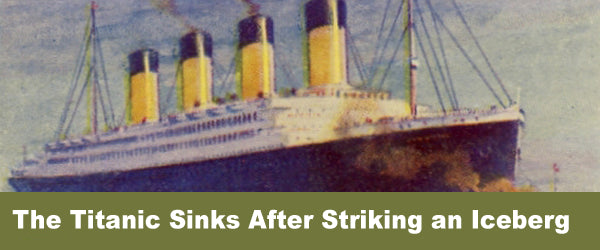
Posted by The Home School in the Woods Team on
By Sam Pak
This week, we’re remembering the tragic loss of nearly 1,500 passengers and crew members aboard the RMS Titanic.
The British Olympic-class luxury passenger ocean liner met its unthinkable end during its maiden voyage on April 14–15, 1912, in the North Atlantic Ocean en route to New York.
The event is memorialized for how shockingly terrible it was, making it one of the worst non-military maritime accidents in history.
Remembering the Titanic
In one moment, thousands of people saw the ship as a beacon of warmth, pleasure, and luxury. In the next moment, the ship would be associated with cold and miserable losses of life.
The sinking of the Titanic would act as a turning point for nations across the globe to enact change in ensuring more robust safety measures regarding navigation.
As bleak as it may be to talk about, it’s important that we remember these events. They serve as reminders that no matter how safe, secure, or promising something may appear, disasters will happen.
Leading up to the ship's departure, it was touted as “unsinkable,” boasting a complex design of the ship’s hull, made up of sixteen watertight compartments. It was said that in the event that the ship took on water in one of the compartments, it would not leak into the others.
Moreover, the complacent arrogance of the manufacturing company that built the ship opted to install twenty lifeboats onto the ship when it had the capacity for sixty-four. While this number of lifeboats would only accommodate half of the ship’s population, it was ironically within the legal requirements.
The idea was that the lifeboats were primarily intended to transport passengers to rescue ships, not as an ample means of saving all of them at once. It was a convenient excuse for the shipping company to reduce the presence of lifeboats on deck, as it helped “de-clutter” the ship for passengers. This was just one of many foolhardy choices that led to the deaths of so many people.
How Did the Titanic Sink?
On the course across the North Atlantic, there had been reports of icebergs that might impede the ship's trajectory. The ship’s skipper, Edward J. Smith, was reluctant to heed such precautions as he was determined to steer the ship ahead at a considerable speed of 22 knots. The goal was put on him to prove that White Star Line’s ship was capable of making the North Atlantic Crossing in six days. To that end, he was compelled to keep the ship moving as fast as possible.
The weather conditions on the night of the Titanic’s sinking were quite cold, dropping into sub-zero temperatures. At the same time, it was a calm night with little to no waves, making spotting an iceberg more challenging. To make matters worse, the two lookouts on duty didn’t have access to their binoculars, which had been mistakenly locked away during staffing shifts prior to the ship's departure.
As you can tell by now, it was a series of poor choices, unfortunate circumstances, and negligence that created the horrifying scenario placed on the lap of Captain Smith.
At about 11:40 PM on April 14th, the lookouts spotted an iceberg directly ahead of the ship. Alerts were made to navigate around the iceberg, but it was too late for the ship to avoid contact with the iceberg. Although they narrowly avoided colliding with the iceberg head-on, the starboard side of the ship grazed a part of the iceberg that was below sea level, creating several gashes in the ship's hull along several compartments.
Distress signals were made to any nearby ships that could lend aid. The only ship that could respond in the Titanic’s vicinity was the Carpathia, which promptly began heading to the Titanic’s location at 12:20 AM.
The ship was rapidly taking on water, causing the bow to submerge. Everyone was thrown into a state of panic as the crew began filling lifeboats.
Due to a lack of clarification, the first lifeboat to be released was only filled with twenty-seven women and children, while it could have held 65 passengers. The disarray on board led to continued poor decisions and hysteria.
At about 2:00 AM, Captain Smith issued a statement to his crew that “it’s every man for himself,” conceding that he was defeated and now determined to go down with his ship. He embraced his fate, as he felt responsible for delivering his passengers to such an awful end.
By about 2:18 AM, the ship lost power, and the now suspended stern snapped, breaking the ship in half and cascading hundreds of passengers into the freezing waters.
It was not until 3:30 AM that the Carpathia could arrive at the scene and collect any lifeboats.
The Flaw of Mankind
The unfortunate events of the Titanic – its design, construction, expectations, and overstretched limitations – were a telling sign of humanity’s hubris.
It was later revealed that the structural features of the ship were perhaps not as fortified as they could have been. Allegedly, decisions were made to save on the costs of building the ship, such as lower quality rivets and iron. The absence of enough lifeboats and unsafe pressures to satisfy corporate-set goals all contributed to the catastrophe.
It goes to show us the pride of man, which went so far as to think the Titanic was truly “unsinkable,” could not resist even the seemingly mundane, like a static iceberg.
It serves to remind us that no man-made construct is immune to the might of God’s creation.
Further Reading
If you’d like to learn about the sinking of the Titanic, you can find more in our America’s History Timeline Set and in our Industrial Revolution Through the Great Depression Time Travelers unit.
Share this post
- 0 comment
- Tags: Timelines, World History
